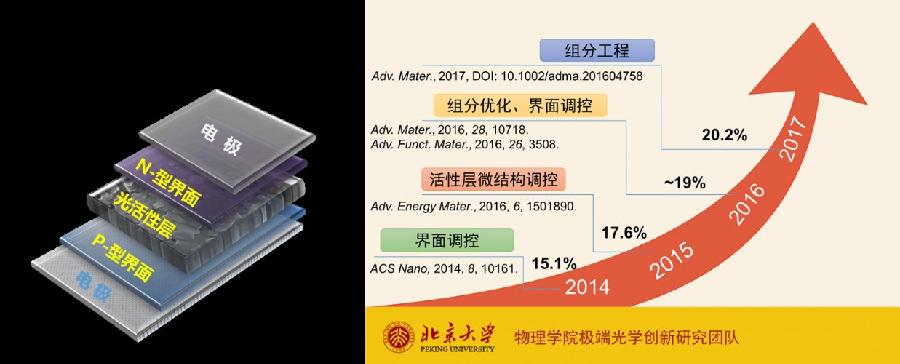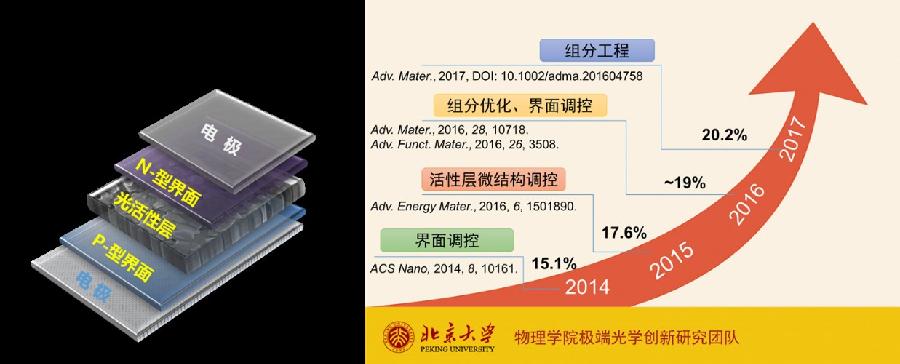近日,《Advanced Materials》刊登了“极端光学创新研究团队”在钙钛矿太阳能电池研究最新进展。研究团队基于醋酸铅前驱体体系制备的钙钛矿太阳能电池获得超过20%的光电转换效率,进一步显示了反式钙钛矿太阳能电池的发展前景。
随着环境问题的日益加剧,太阳能以其清洁、可再生的优势引起了科研界和产业界的广泛关注。其中,高效、经济的光伏技术也成为了当前学术研究和产业发展的热点之一。近年来,一种新型光伏技术――钙钛矿太阳能电池以其易制备、低成本和高效率的特点走入人们的视野,成为新型光伏技术的新宠。短短七年之内,钙钛矿太阳能电池的光电转换效率实现了跨越增长,从最初的3.8%提升至现在的22%以上,表现出了极大的优势和潜力。
钙钛矿太阳能电池分为正式(n-i-p)和反式(p-i-n)两种结构。常规的正式器件通常需要致密或介孔氧化物作为电子传输层,其制备工艺相对复杂,且与柔性基底的兼容性不好。相比较而言,反式结构器件因制备工艺简单、可低温成膜、无明显回滞效应等优点受到越来越多的关注,但是其光电转换效率还稍显不足。
针对反式结构钙钛矿太阳能电池器件效率较低的问题,北京大学 “极端光学创新研究团队”的朱瑞研究员和龚旗煌院士等从钙钛矿薄膜形貌控制、界面调控及组分优化等角度进行了全面系统地研究,在过去的两年中取得了一系列创新成果。他们利用醋酸铅前驱体体系,先是将微量溴甲胺作为添加剂应用于钙钛矿前驱体溶液中,该策略可以有效改善钙钛矿薄膜的表面形貌,使其光学和电学性能均得到明显提升,最终,基于醋酸铅前驱体的反式平面结钙钛矿太阳能电池的光电转换效率从14.26%大幅度提高至18.32%,结果发表在《Advanced Functional Materials》上,并被选为封底内页,发表后连续两个月的访问次数在该刊排名前五,也是该刊2016年度访问次数最多的文章之一(Adv. Funct. Mater., 2016, 26, 3508,博士生赵丽宸和罗德映为共同第一作者);随后,又借助界面调控,首次在钙钛矿太阳能电池领域提出了“电荷载流子平衡”的概念,并系统地研究和实现反式钙钛矿太阳能电池器件内的电荷载流子平衡,将反式钙钛矿太阳能电池光电转换效率进一步提升至接近19%,该结果发表在《Advanced Materials》上(Adv. Mater., 2016, 28, 10718,博士生陈科、胡芹和刘堂昊为共同第一作者)。之后,又进一步采用双源前驱体溶液法,在体系中引入“甲脒”有机阳离子将吸收光谱拓展至近红外区域,并结合对空穴传输层的优化,确保了电荷有效传输和收集,同时提升了器件的开路电压,最终将光电转换效率提升至20%以上,该结果发表在《Advanced Materials》上,是目前报道的基于醋酸铅前驱体体系钙钛矿太阳能电池的最高性能(Adv. Mater., 2017, DOI: 10.1002/adma.201604758,博士生罗德映和赵丽宸为共同第一作者)。此外,他们还撰写了关于反式结构钙钛矿太阳能电池的综述文章,发表在《Advanced Energy Materials》上,对反式钙钛矿太阳能电池的发展现状进行了系统归纳,并对未来的前景进行了展望(Adv. Energy Mater., 2016, 6, 1600457,博士生刘堂昊为第一作者)。
该系列研究工作得到中国国家自然科学基金委、科技部、北京大学人工微结构和介观物理国家重点实验室、“极端光学协同创新中心”、“2011计划”量子物质科学协同创新中心、“青年千人计划”和美国劳伦斯伯克利国家实验室(LBNL)等单位的支持。

“极端光学创新研究团队”在高效反式钙钛矿太阳能电池研究取得系列创新进展
Recent Advances in Highly Efficient Inverted Planar Heterojunction Perovskite Solar Cells
Recently, Prof. Rui Zhu and Prof. Qihuang Gong at Department of Physics, Peking University working with the collaborators, Dr. Wei Zhang from University of Surrey, Dr. Feng Liu and Prof. Thomas P. Russell from Lawrence Berkeley National Laboratory, and Prof. Henry J. Snaith from University of Oxford, have made great efforts in highly efficient inverted planar heterojunction perovskite solar cells. Eventually, they have achieved power conversion efficiencies exceeding 20% by using a simple antisolvent-free one-step solution process. This result has demonstrated that the inverted-structure perovskite solar cells have great potential in the research field of photovoltaics.
Owing to the global energy crisis and environmental issue, clean and renewable solar energy has attracted wide attention both from academia and industry. Among them, studies of high-efficiency and low-cost photovoltaic technologies are current “research hot spots”. Perovskite solar cells (PerSCs) have developed rapidly due to their easy fabrication, low cost and high efficiency. Presently, the device efficiency has reached over 22% through the intense efforts of researchers from all over the world. Consequently, the PerSCs have great potential and advantages in the next-generation photovoltaics in comparison to the other photovoltaic technologies.
Normally, the thin-film PerSCs have two kinds of device structures: regular structure (n-i-p structure) and inverted structure (p-i-n structure), in which the bottom transparent electrode (e.g., ITO or FTO) is believed to collect either electrons or holes generated in perovskite photoactive layer. For the regular-structure PerSCs, TiO2 is the most commonly used electron selective contact layer sandwiched between the transparent electrode and perovskite photoactive layer, but it is usually required to be sintered over 450 °C. Although the efficiency of TiO2-based regular device has already reached over 21%, relatively high temperature for the device fabrication process is not compatible with cost effectiveness. Recently, perovskite solar cells with the inverted planar heterojunction (p-i-n structure) have been becoming more and more attractive, owing to their easy fabrication, cost effectiveness and suppressed hysteresis characteristics. Some recent advances in the device performance and stability have suggested their promising future. However, the device efficiency is still relatively lower than those of the regular-structure PerSCs so far.
To address the challenge of the low efficiency for the inverted planar heterojunction PerSCs, Prof. Rui Zhu and Prof. Qihuang Gong at Department of Physics, Peking University, have devoted their great efforts in morphology control, interface modulation and composition engineering, and achieving series of remarkable results published in some top journals. They have used trace amounts of a methylammonium bromide (MABr) as an additive in the Pb(Ac)2-based precursor solution, which is shown to improve the perovskite film morphology, crystallinity and optoelectronic properties, leading to enhanced device performance. A champion power conversion efficiency of 18.32% with a stabilized output efficiency of 17.60% has been achieved in the inverted planar heterojunction PerSCs. This work was published in Advanced Functional Materials and selected as inside back cover. This paper was also the most accessed paper in the journal in April and May, 2016 (Adv. Funct. Mater., 2016, 26, 3508. Lichen Zhao and Deying Luo contributed equally to this work). Subsequently, they have proposed the concept of charge-carrier balance transport in the inverted planar heterojunction PerSCs based on interface modulation, and the device efficiency has been improved to ~19%. This work was published in Advanced Materials (Adv. Mater., 2016, 28, 10718, Ke Chen, Qin Hu and Tanghao Liu contributed equally to this work.). Recently, a dual-source precursor approach has been developed to incorporate the formamidinium (FA) cation into the methylammonium-based perovskite, which could expand light absorption of perovskites to near infrared region. Combining with the optimization of the hole transporting layer, the improved open circuit voltage (Voc) in inverted planar heterojunction PerSCs based on mixed-cation perovskite has been achieved without sacrificing fill factor (FF) and short circuit current density (Jsc). With these efforts, they have obtained the inverted planar heterojunction PerSCs with efficiencies exceeding 20%. This work was published in Advanced Materials (Adv. Mater., 2017, DOI: 10.1002/adma.201604758, Deying Luo and Lichen Zhao contributed equally to this work). Moreover, a review of “inverted perovskite solar cells: progresses and perspectives” has published in Advanced Energy Materials (Adv. Energy Mater., 2016, 6, 1600457, Tanghao Liu is first author).
These works were supported by the Ministry of Science and Technology of China, the National Natural Science Foundation of China, State Key Laboratory for Artificial Microstructure and Mesoscopic Physics, 2011 Collaborative Innovation Center of Quantum Matter, China, Collaborative Innovation Center of Extreme Optics, 1000 Talents Program for Young Scientists of China, the Advanced Light Source Doctoral Fellowship in Residence at the Lawrence Berkeley National Laboratory.

Device architecture of the inverted planar heterojunction perovskite solar cell (a) and (b) the road mapping of power conversion efficiencies improved using various device optimization strategies by the team of extreme optics in the department of physics.